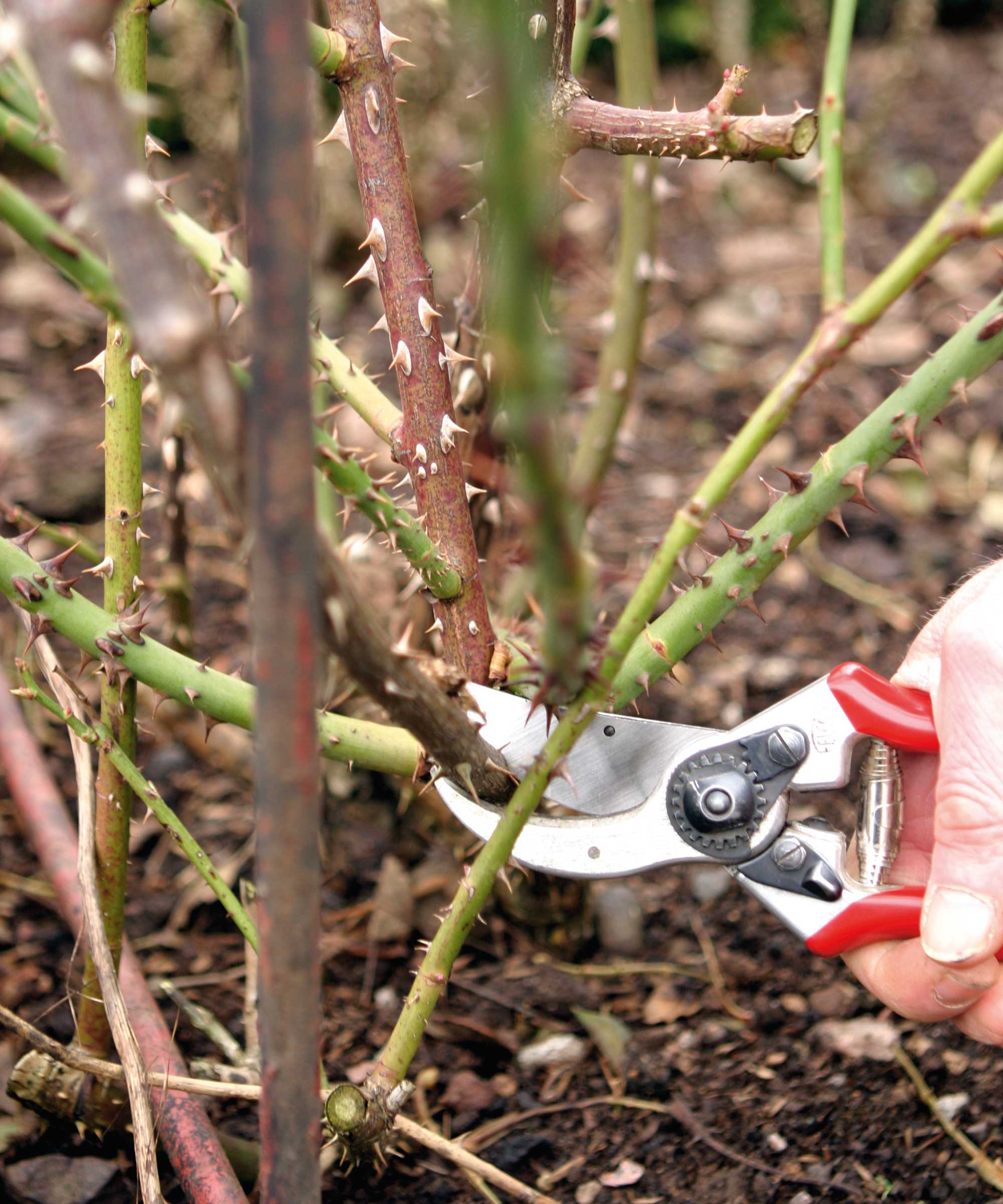Heirloom roses: top tips on how to grow these classic blooms
Get growing success with our tips on how to grow heirloom roses – with their fabulous fragrance and timeless beauty, they're a beautiful addition to any plot


Heirloom roses are also known as heritage roses, antique roses, old garden roses, shrub roses, and old fashioned roses. Strictly speaking, these are roses that were developed before the first modern rose arrived on the scene in 1867 but, in practice, any rose developed more than a hundred years ago can be classified as a heirloom rose.
When it comes to rose care, this type is relatively undemanding. Sue Martin of Piedmont Master Gardeners says, 'The heirlooms are described as hardy, disease-resistant, carefree, prolific shrubs that don't require much tending.
'But the show-stopper is their wondrous fragrance,' she continues, 'mentioned over and over again. They also offer a wide variety of forms ranging from shrubs to climbers to tall, arching plants up to 20 feet in height.'
The other feature that is typical of heirloom roses is the beautiful structure of the individual double flowers. Collectively, in early summer, they provide a mass of color. However, it is mainly restricted to the range between deepest, richest reds to pure white and everything in between.
Sometimes, there are so many flowers that the foliage is almost hidden. But look closely at the individual flowers, at the intricate patterns of petals, and you can see why heirloom roses are so popular for cutting for a vase. Even one flower, with its structure, color, and intoxicating scent, is a joy.
When and where to plant heirloom roses
Planting bare root roses is best done as soon as they arrive (which will usually be in fall, winter, or early spring) unless the soil is waterlogged or frozen. If you must wait, follow the guidance that comes with your roses. Usually, this means keeping the roses, in their packaging, in a cold but not frosty place until conditions improve.
Plant your potted roses at any time that soil conditions allow.
Heirloom roses enjoy plenty of sunshine. However, in the south, they can take a few hours of light shade (such as from a high tree canopy). In fact, a little afternoon shade will help prevent richer-colored flowers from fading. They appreciate rich, well-drained soil conditions.

How to plant heirloom roses
Heirloom roses are long-lived plants so repay thorough preparation. Amend the soil with well-rotted garden compost or bagged soil improver from a retail nursery. For bare root roses, soak the roots in a bucket of water overnight before planting, trim off any dead or broken shoots or roots, then dig a hole that will accommodate the roots without having to force them into place.
Work amended soil in around the roots, firming with your fingers until there are no air pockets, then finish by firming with the toe of your boot and top off with a mulch.
Prepare just as thoroughly for pot-grown roses. Before planting, water your potted rose with liquid feed added to the watering can, then plant carefully retaining as much potting soil on the roots as possible. Firm the soil well around the rootball, then water again with liquid feed before mulching.

How to prune heirloom roses
The thought of pruning roses of the heirloom variety can be daunting, but over at Lowe's, they sum it up well. 'Shrub roses generally don't need much pruning,' they explain, 'other than removing weak, spindly, or old stems. Lightly prune outer stems in early spring to maintain a compact size. On old shrub roses with a crowded habit, remove thick, older stems that are no longer productive.'
Early spring is the time to prune, just as the buds along the bare stems are starting to grow, although once-flowering varieties are best pruned immediately after their burst of early summer blooms.

How to care for heirloom roses
Heirloom roses are tough and resilient plants that will often provide a good display even when neglected. But just a little care can still make an enormous difference.
Fertilizing plants annually with rose food will help keep your roses growing well. Some brands also include an insecticide that will give protection from rose pests. An annual mulch of well-rotted garden compost, soil improver, or bark immediately after feeding will help smother weeds, retain moisture in dry seasons, and protect the roots from heat in hot summers.
Roses suffer from a number of pests that either suck the sap from the shoots or eat the leaves. In many cases, encouraging predatory insects and attracting birds will help keep them under control but be prepared to use your favorite insecticide if necessary.

How to make more heirloom roses
You can make more heirloom roses by taking rose cuttings.
Take hardwood cuttings: these are cuttings taken in late fall or early winter. Cut pieces of stem about 9in (23cm) long from the growth made earlier in the year. Snip just above a bud at the top, and just below a bud at the base.
Fill a gallon pot with moist potting soil and push about six cuttings into the compost, evenly spaced and to about half their depth. Stand the pot in a bright place out of full sun – and wait. In spring, the buds should start to grow and when roots emerge from the holes in the base of the pot, the individual rose plants can be removed from the pot and planted.

Do heirloom roses repeat flower?
Heirloom roses have been divided into over 20 types. But, they can be conveniently placed in two main groups: those that flower prolifically, but usually just once in early summer (once-flowering), and those that also flower either again later in the summer or continuously until late summer or fall (repeat-flowering, or remontant roses).
Websites and catalogs will always specify the type of each rose offered, so you can choose the best one for your landscaping with roses plans. Many websites feature advanced search facilities that allow you to specify repeat flowering if that is important to you.
Examples of excellent once-flowering heirloom roses include:
- 'Great Maiden's Blush' (Alba rose)
- 'Fantin-Latour' (Centifolia rose)
- 'Tuscany Superb' (Gallica rose)
- 'Gruss an Aachen' (Polyantha rose)
Examples of fine repeat-flowering heirloom roses include:
- 'Ferdinand Pichard' (Bourbon rose)
- 'Quatre Saisons' (Damask rose)
- 'Reine des Violettes' (Hybrid Perpetual rose)
- 'Buff Beauty' (Hybrid Musk rose)

Are heirloom roses deer resistant?
Although some heirloom roses are very thorny, most are not deer-resistant plants. Deers especially enjoy the soft new shoots that develop through spring, but will also eat the sharp, prickly rose stems in winter if they are sufficiently hungry.
Three native roses are said to be more deer resistant than other roses: swamp rose (Rosa palustris), Virginia rose (Rosa virginiana) and pasture rose (Rosa carolina), all with single pink flowers. But even these will sometimes be eaten.

Are heirloom roses invasive?
Most heirloom roses pose no danger of becoming invasive plants, partly because many do not produce hips in large numbers so do not spread easily from seed. Some will spread by suckers in the garden, but are rarely invasive in natural situations.
The one rose that is a genuine invasive pest is the Japanese multiflora rose (Rosa multiflora), with its clusters of small white flowers and many small hips. This is not now sold, should never be planted, and should usually be removed if it arrives on your property.
In some coastal areas, especially in the northeast, the seaside rose (Rosa rugosa) with its large, single, pink or white flowers and fat, red hips has spread by suckers and seeds to sand dunes, smothering native vegetation. Check your local situation before planting varieties of the seaside rose.

Where to buy heirloom roses
A few heirloom roses are available, in flower, in retail nurseries and in big box stores although these outlets tend to focus on modern rose varieties.
By contrast, a large range of heritage rose varieties is available from specialist rose growers who ship roses across the country. However, it pays to start by checking out rose growers in your general area as they will be growing varieties that suit your climate.
Rose nurseries either ship plants bare root or in pots. Bare root plants are grown in the ground in the nursery and are lifted for dispatch between late fall and early spring. The soil is knocked off and the roots wrapped for shipping. Different suppliers sell different sizes of plants in pots: one or two gallon, or sometimes smaller.
Both types will grow well. Bare root plants cost much less to ship, but need care if they cannot be planted at once on arrival.
Where to buy heirloom roses in the US:
- Shop heirloom roses at Lowe's
- Shop heirloom roses at Antique Rose Emporium
- Shop heirloom roses at Heirloom Roses
- Shop heirloom roses at Monrovia
- Shop heirloom roses at Rogue Valley Roses
Where to buy heirloom roses in the UK:

Graham Rice is a garden writer who has won awards for his work online, and in books and magazines, on both sides of the Atlantic. He is a member of a number of Royal Horticultural Society committees and the recipient of the 2021 Garden Media Guild Lifetime Achievement Award.
